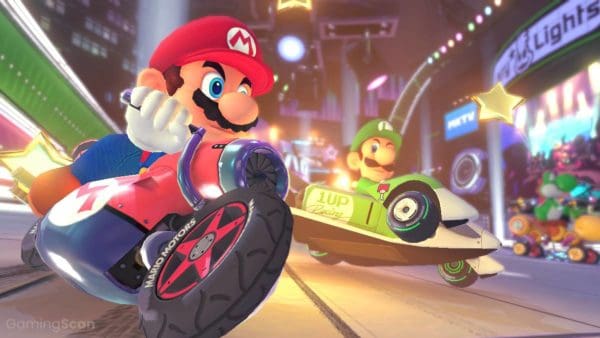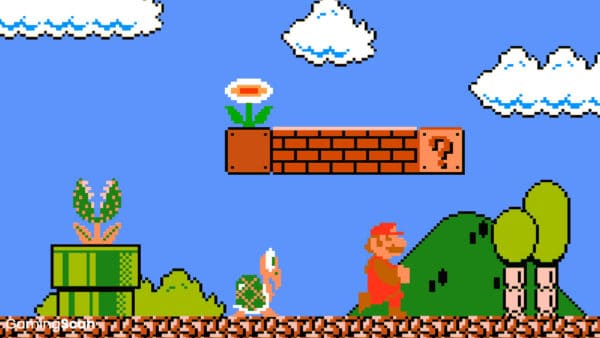For a series whose gameplay appears to stay the same across all releases, you would be surprised to learn there have been a large number of changes to Mario Kart over the last two decades, reaching far beyond merely better graphics.
The kart racing franchise has seen a transition from 2D sprites to full 3D, from a standard control scheme to emphasizing motion controls, and most recently, it was adapted as a mobile game. While some entries are far better than others, each of the 14 Mario Kart games reflects a moment in gaming history.
Following the release of Mario Kart Tour on mobile devices, we have created a timeline to highlight the history of Mario Kart games, including handheld, home consoles, and arcade releases.
We’ll be updating this list in the future, so make sure to check back.
And if you’d like to receive more gaming recommendations, consider reading through our other curated lists:
Table of ContentsShow
Super Mario Kart
Release Date: Sep 1, 1992
Platform: SNES
Mario Kart’s legacy begins with Super Mario Kart which was released for the Super Nintendo Entertainment System. The iconic racing game allows you to select eight playable characters from the Super Mario universe and compete in races set on 20 different tracks, including fan favorites like Donut Plains.
In addition to races, Super Mario Kart presented Battle mode, an alternate game mode where the goal is to eliminate your rivals by using power-ups.
While this game is responsible for establishing some of the staples for the series going forward, it also features a fair share of unique quirks that aren’t present in later games.
For one, AI-controlled drivers would use special power-ups during races that were character-specific and couldn’t be accessed by the player. Second, each track is relatively short compared to later iterations, resulting in an increase in the number of laps to 5 versus the standard 3 we get today.
Races saw players assigned a limited number of lives which would cause them to lose and “rank out” whenever they were depleted. Super Mario Kart also marks the debut of playable characters like Koopa Troopa and Donkey Kong Jr., both of which have appeared in various spin-offs since then.
At the time, the game was considered a graphical achievement, using free rotations and plane-scaling to create a 3D effect on the SNES’ hardware.
Mario Kart 64
Release Date: Feb 10, 1997
Platform: N64
Nintendo’s second attempt at making a kart racer introduced a bunch of improvements over the original. The switch from SNES to the N64 hardware made it possible to render fully-3D polygonal-based graphics for tracks; this led to more interestingly designed tracks with more environmental objects such as bridges, walls, and pits.
While characters and items retained their 2D pre-rendered sprites, they were now accompanied by digital voice acting, a system that separated racers into different weight classes, 4-player support, Mirror mode, and Time Trial courses.
Mario Kart 64 also introduced some new items such as the Spiny Shell, which we now call the Blue Shell, the annoying Fake Item Box, and the speed-boosting Golden Mushroom.
Included were 16 standard racetracks in addition to 4 battle courses and 8 playable characters, with Koopa Troopa and Donkey Kong Jr. replaced by Wario and Donkey Kong. Mario Kart 64 was later released for Wii and Wii U through Virtual Console.
Mario Kart: Super Circuit
Release Date: Aug 27, 2001
Platform: GBA
The first handheld Mario Kart game was released in 2001 for the Game Boy Advance. Mario Kart: Super Circuit preserves many of the features established by its predecessors while sporting a few new ones.
For the first time, players were able to unlock retro tracks from previous games, and in addition to winning trophies at the end of a race, players were also awarded a ranking based on their performance.
Super Circuit also introduced the ability to play in a new Linked VS mode with other players, with only one cartridge required.
This mode was restricted in that players could only choose from the four SNES Mushroom Cup courses and would be required to play as various colored Yoshi; however, if all players had a cartridge, all racers and courses were available. The GBA’s Link Cable also allowed players to swap ghost data for Time Trials.
Mario Kart: Super Circuit was later released for 3DS and Wii U through Virtual Console, with the former only being obtainable through the Nintendo 3DS Ambassador Program.
Mario Kart: Double Dash
Release Date: Nov 17, 2003
Platform: GC
Mario Kart: Double Dash, which surprisingly made many changes to the series’ formula, especially in terms of gameplay, was released in 2003 for the Nintendo GameCube.
The most obvious change was the emphasis on co-op, with two riders assigned to each kart. With the option to swap between both characters at any time, one player was tasked with driving while the other used items.
The shift in gameplay coincided with an expanded roster, with 9 playable characters returning in addition to 11 new ones: Diddy Kong, Bowser Jr., Birdo, Princess Daisy, Waluigi, Koopa Paratroopa, Baby Mario, Baby Luigi, Petey Piranha, King Boo, and Toadette.
Each combination of drivers would grant access to unique power-ups such as fireballs for Mario and Luigi, or giant bananas for Donkey and Diddy Kong. Characters were also given custom-designed karts based on their appearance and personality.
Mario Kart Arcade GP
Release Date: Oct 10, 2005
Platform: Arcade
Mario Kart Arcade GP would be the first Mario Kart title developed by Namco for arcades and released in 2005. Although it was not the first arcade entry in the series, it would be the first one to receive massive support from Nintendo.
The game features 11 playable characters, 24 tracks, and adjusted mechanics which adapted the traditional Mario Kart for the arcades.
In it, players are tasked with reaching the finish line within a limited amount of time. Arcade GP introduces some new power-ups not found in other Mario Kart games and features a built-in camera that can take a photograph of the player’s face to display above their character during races.
Exclusive to the GP series are three playable characters, Pac-Man, Ms. Pac-Man, and Blinky the ghost.
Mario Kart DS
Release Date: Nov 14, 2005
Platform: DS
The second title to appear on a handheld is Mario Kart DS, released in 2005 for the Nintendo DS. The game returns to the traditional formula prior to Double Dash and sees characters racing in individual karts.
Included is a new Mission mode that tasks players with completing eight objective-based missions ranging from collecting coins to attacking enemies from Super Mario 64 DS.
Mario Kart DS incorporated the handheld’s dual-screen functionality by using the top screen to display the racer’s kart and the bottom to show either an overview of the track or a bird’s-eye view of their surroundings. New characters appear in the form of Dry Bones and R.O.B. in addition to new Blooper and Bullet Bill power-ups.
Unlockable retro tacks make a return appearance and become a staple for the series going forward. Multiplayer benefited from the DS’s Download Play feature, which allowed for wireless multiplayer using multiple devices and only a single copy of the game. Mario Kart DS was then released for Wii U through Virtual Console.
Mario Kart Wii
Release Date: April 27, 2008
Platform: Wii
Mario Kart Wii is considered by many to be one of the best entries in the series. The game marks the debut of motion controls in Mario Kart and the addition of Bikes as a new vehicle. Moreover, it includes a new system that allows players to perform tricks while driving in exchange for a short burst of speed.
Mario Kart Wii features a massive 24-character roster, the largest of any entry at the time. It introduces players to Baby Daisy, Baby Peach, Funky Kong, Dry Bowser, and Rosalina; additionally, players’ Mii characters made their first appearance as playable characters.
Power-ups like the POW Block, Mega Mushroom, and Thunder Cloud, all made their first and last appearance in main series. Furthermore, the unlockable retro tracks feature expanded to Battle mode, with one retro course from each game in the series available.
The existence of Nintendo Wi-Fi Connection on the Wii meant races could now be taken online, with support for up to 12-player online multiplayer in VS mode and Battle mode.
This was accompanied by the “Mario Kart Channel,” an optional downloadable channel on the Wii Menu that lets players check their regional/global Time Trial rankings, send/receive ghost data, and participate in worldwide tournaments on modified courses with unique objectives.
Mario Kart Arcade GP 2
Release Date: 2008
Platform: Arcade
Mario Kart Arcade GP, a second arcade game released in 2008 and considered to be a sequel to the original Arcade GP title, features the same playable characters as its predecessor.
Moreover, in addition to a few new faces, internet-sensation Waluigi and Mametchi from the Tamagotchi series both make an appearance.
This game also introduced unique karts for each character inspired by the designs from Mario Kart DS. Additional changes include even more power-ups than previous entries and new color commentary, which could be toggled on or off before a race.
Mario Kart 7
Release Date: Dec 4, 2011
Platform: 3DS
Mario Kart 7 was released in 2011 for the 3DS, and it included the option to play with 3D stereoscopic graphics as well as motion controls using the system’s built-in gyroscope. Additionally, it’s the only entry to offer players the option to race in first-person and steer vehicles by turning the device itself.
Other new features include vehicle customization, with players being able to unlock additional parts such as different kart frames, tires, and even retractable hang gliders that allow you to glide in the air.
Accompanying each of these was an expanded roster that introduced Metal Mario, Lakitu, Wiggler, Honey Queen, and Shy Guy as standalone, playable characters. Support for online multiplayer via Nintendo Network saw the number of players in any given race reduced from 12 to just 7.
Mario Kart 8
Release Date: May 30, 2014
Platform: Wii U
It took three years for fans to receive a new Mario Kart game, with Mario Kart 8 releasing on the Wii U in 2014. It introduced new anti-gravity sections where players would have their kart’s tires turned sideways as they drove over walls and ceilings, resulting in the creation of alternate paths in familiar tracks.
During these sections, players can crash into other racers or special bumpers to receive a boost in speed, the opposite of what occurs in normal gravity.
The game also introduced ATVs as a third vehicle type, 4-player support for Grand Prix races, and more playable characters, including Baby Rosalina, Pink Gold Peach, and the Koopalings.
Mario Kart 8 is the first entry to offer downloadable content in the form of character packs and new tracks. Add-on racers included Tanooki Mario, Cat Peach, Dry Bowser, Link from The Legend of Zelda, and the Villager and Isabelle from Animal Crossing.
Mario Kart 8 is considered by many to be the best entry to date, boasting HD graphics and live-orchestrated music in addition to being the first Mario Kart to receive post-release updates, which added new features and QoL improvements.
Mario Kart Arcade GP DX
Release Date: 2014
Platform: Arcade
Mario Kart Arcade GP DX was released in 2013, and it included the kart gliders from Mario Kart 7 in addition to more racers such as Bowser Jr., Rosalina, King Boo and Lakitu. Additionally, the game included a crossover appearance from Don-chan from the Taiko no Tatsujin series and a redesigned Pac-Man.
A new “Alter-Ego” mode used online functionality to have players race against ghosts set by other players while a new “Team” mode allowed two players to combine their karts to form a more powerful vehicle as they raced against two AI-controlled opponents.
Mario Kart 8 Deluxe
Release Date: April 28, 2017
Platform: Switch
Mario Kart 8 Deluxe is a modified port of Mario Kart 8 that was released in 2017 for the Nintendo Switch. It includes the original game along with most of the post-launch downloadable content and some extra features.
Boo and Super Mario Kart Feathers are reintroduced as items after a lengthy hiatus. Players are also now able to carry two items at once, and more racers join in on the action, including Bowser Jr., Dry Bones, King Boo, Gold Mario, and girl/boy Inklings from Splatoon. Deluxe also features a reworked Battle mode.
Mario Kart Arcade GP VR
Release Date: Oct 1, 2018
Platform: Arcade
Mario Kart Arcade GP VR is the most recent Mario Kart arcade release, appearing in virtual reality arcades in 2018. The game features a dramatic shift in the traditional formula by replacing Item Boxes with balloons used to store items.
Once a player has obtained a balloon, they must then make a variety of hand gestures to use it, with each item type assigned a unique gesture.
The VR title includes a much smaller roster, with players only able to select Mario, Luigi, Peach, or Yoshi. During races, AI-controlled Bowser and Wario appear, despite not being playable in the game.
Mario Kart Tour
Release Date: Sep 25, 2019
Platform: Android / iOS
Mario Kart Tour is the first entry in the series to be released on mobile devices, supporting both Android and iOS. Returning characters are accompanied by three new ones, Pauline, Peachette, and Musician Mario.
Content is split into different tours that stand in for cups in previous games, with each tour consisting of different featured tracks that are rotated bi-weekly.
The game makes a massive departure from the classic Mario Kart format by changing the win conditions for any given race. Instead of finishing in the first place, players must accumulate the most points to receive the most Grand Stars.
A new gameplay mechanic called Frenzy is introduced, which is triggered if a player gets three of the same power-up in their item slots, allowing them to use said item multiple times while granted invincibility.
Despite these numerous changes, Mario Kart Tour features the most straightforward control scheme of any entries, with players only required to steer the kart and use items. An in-game app shop allows players to spend in-game currency called Rubies in exchange for loot boxes, including new racers, karts, and gliders with varying drop rates.
Mario Kart Tour also introduces the Gold Pass, a subscription-based service that increases the number of rewards during races and unlocks 200cc racing speed.




